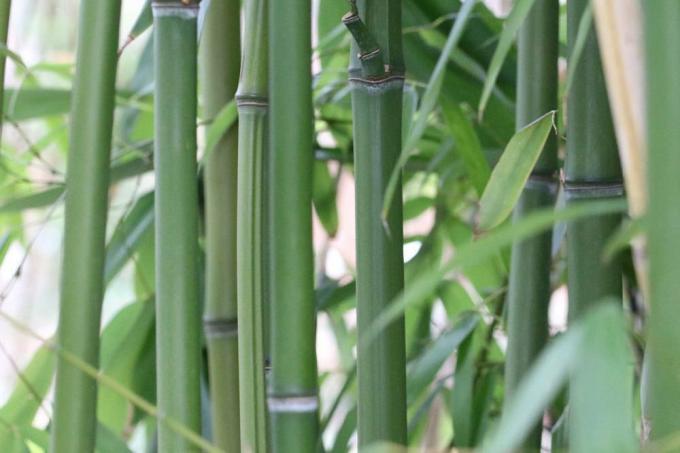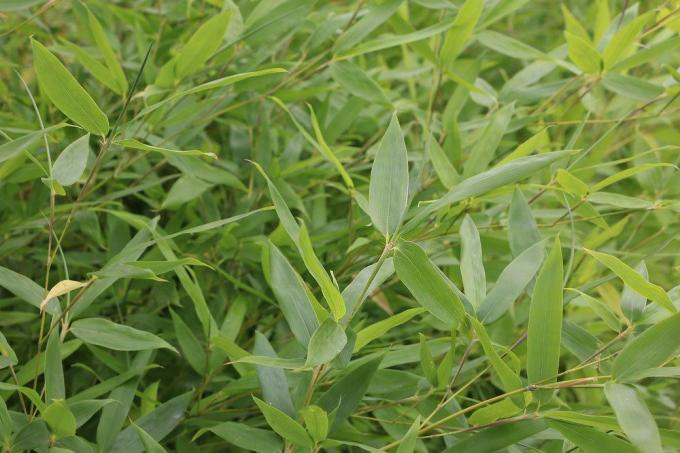
table of contents
- Bamboo propagation
- share
- Cuttings
- Bury stem segments
- Seeds
Bamboo is a subfamily of sweet grasses that bears the scientific name Bambusoideae. The plants are found in all parts of the world with the exception of Europe and the Antarctic. Various species are cultivated as ornamental and useful plants in Central Europe. There are hardy specimens that can spend the winter outdoors. It is easy to multiply, although not all typical methods promise success. The most common variant is the division.
Bamboo propagation
The Fargesia species, known as garden bamboo, belong to the clumpy growing bamboo plants, just like the Borinda species. They develop a compact root system, which is composed of bulbous, thickened rhizomes and fine roots. These plants reproduce mainly via seeds, while Phyllostachys and Pseudosa species use vegetative methods of reproduction. They form underground rhizomes that develop creeping runners. In this way spread The bamboo spreads over large areas if there are no root barriers restricting growth.
Root formation on the stalk
The Bambusa species native to the tropics also develop short and strongly thickened tubers that are used for vegetative reproduction. Some species of this genus follow a spreading strategy that is atypical for bamboo. They are able to develop roots from the nodes between the internodes. Root attachments already develop on growing plants under high humidity, so that broken pieces of stalk can take root when they come into contact with the earth.

tip: When propagating, orientate yourself on the natural growth characteristics in order to successfully breed young plants. Not every method of propagation is suitable for the different species.
share
This type of propagation is used for runners-forming bamboo plants. Even clumpy growing species are multiplied by rhizome division. This method preserves the properties of the mother plant. The measure is ideal if you want to rejuvenate stocks that have gone out of shape. Viable young plants emerge within a short period of time.
time
Between March and April there are ideal conditions for pruning root cuttings. The plants then begin to sprout again and should no longer be disturbed. If you missed the timing, you can wait until fall to share. Choose a mild and humid day for the measure. Rainy weather turns out to be favorable, as the roots do not dry out as quickly and then grow better.
method
Completely dig up the root ball of the bamboo plants. So that you can better recognize the interfaces on the rhizome, it makes sense to shower the roots with water. Use a wood splitter to cut up strong roots. However, smaller rhizomes can also be split up with rose scissors. Each piece of rhizome should have at least two to three nodes and shoots so that it grows well in the new location.
- Plant partial roots in a nutrient-poor growing medium
- Place the vessel in a shady place
- Water the substrate well
- Reduce leaf mass, side branches and stalks by a third
tip: To prevent obsolescence, you should separate the old rhizome stick when dividing and use the newly created sections for further cultivation.
Cuttings
For this method of propagation, the bamboo needs the ability to form roots from axillary buds. However, only a few species native to the tropics have this property. Representatives from the moderate latitudes are not suitable for propagation by cuttings. The bamboo should not be older than three years and have shoots with a diameter of 2.5 centimeters. Cuttings from larger plants tend to form roots more easily.
method
Cut pieces of stalk about 10 inches long from a healthy shoot. To do this, use a sharp knife and place the blade at an angle of 45 degrees to the stalk in order to obtain a sloping cutting surface. Each section should have at least two nodes and two internodes. In a suitable location, it takes between 14 and 21 days for fresh leaves to appear on the top node.
- Dip the top end in wax to seal
- Coat the lower interface with rooting hormone
- Put the shoot in potting soil
- Moisten the substrate
Bury stem segments
This method is a special method of propagating cuttings and is used to quickly rejuvenate old stocks. In order for it to work, the stem member must be able to form roots. When using bamboo poles, there are often leftovers that, in tropical to subtropical regions, are stuck vertically into the earth and buried about one to two hand's widths. A link should have at least three eyes. The substrate must be kept moist. It takes two to three weeks for the first shoots to poke through the surface of the earth.
Seeds
Propagation via seeds requires patience and is not always promising. Within the Bambusoideae there are species that bloom at different intervals. However, some representatives only develop flowers every 80 to 120 years. But there are varieties that bloom more often but hardly develop germinable seeds. You can buy seeds in stores and propagate them by sowing. Young plants grown in this way differ from the parent plants, as they contain the genetic make-up of different plants. They can be clearly different from the original plants in terms of size, habit and color.
method
The seeds need stratification. Therefore, store the seeds in a bag filled with sand in the refrigerator for four to eight days so that they are stimulated to germinate. Use a plastic bowl and then fill it with nutrient-poor potting soil. Alternatively, peat or coconut fibers are also suitable. Mix the material with sand, clay granules or perlite in a ratio of 1: 1. This ensures a high level of permeability. Spray the substrate with water, being careful not to cover the seeds with soil. The seeds germinate in the appropriate location after about two to three weeks.
- Cover the vessel with plastic wrap
- ventilate daily
- Place the bowl in a bright place
- alternatively install a plant lamp

tip: Tropical species germinate when the temperature is 32 ° C during the day and at least 22 ° C at night. For hardy bamboo plants, however, 26 ° C is sufficient.




